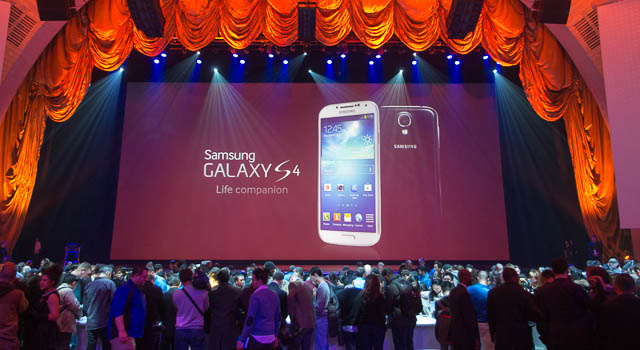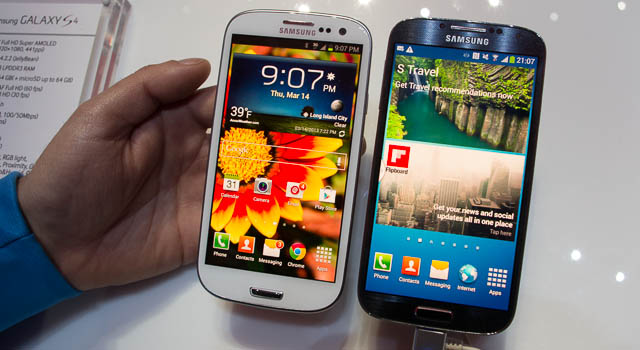
New York’s iconic Times Square was plastered with billboards from Korea’s Samsung Electronics this week and, come Thursday evening, the venue played host to a very public launch event for the Korean company’s new flagship smartphone, the Galaxy S4.
Gigantic screens showed proceedings happening live a dozen blocks away at the 6 000-seat Radio City Music Hall. The message Samsung was sending was clear: “It’s great at the top, and we plan to stay here.”
Actor and singer Will Chase served as master of ceremonies and various other actors played multiple roles as Samsung showed off the S4’s features using theatrical scenes of varying levels of banality. The keynote may have been forgettable, but the star of the show — the device itself — won’t have that problem.
The decadence of the launch is a reminder of Samsung’s growing dominance in smartphones. With money to burn and a hugely successful financial year behind it, perhaps it’s fitting the company opted to launch the S4 in the US, rival Apple’s home ground.
The huge electronic billboards on Times Square carried messages like “Be Ready 4 the next Galaxy”, while rival Korean rival LG Electronics took the chance to have a dig by using its own space to display messages like “LG Optimus G is here 4 you now” and “It’ll take more than 4 to equal one LG Optimus G”.
Similarly, Taiwan’s HTC had promotional staff dishing out bottles of water and snacks wrapped in HTC One insignia to those queuing to get into Samsung’s event. Of course, these potshots only reinforce the fact that Samsung increasingly dominates the Android smartphone market.
Presenting a concise history of the Galaxy range and a list of the S4’s salient features, JK Shin, Samsung’s president for IT and mobile, said the S4 is “slimmer yet stronger,” meaning there’s “less to hold with more to see”.
The S4 has almost exactly the same proportions as its predecessor, but it’s what’s below the newly reinforced polycarbonate shell that has hearts racing. Shin reeled off the new features casually — Smart Scroll, Air Smart Pause, Air View, S Translator, Group Play, S Health, Samsung Knox… The list went on.
Casting a cursory eye over at the Galaxy S4, it’s easy to mistake it for its predecessor. Externally, the differences between the devices are minimal: its corners are a little less rounded, the screen is marginally bigger (five inches over the S3’s 4,8 inches) and it’s encased in polycarbonate rather than the glossy plastic of the S3. But beneath the surface, the S4 is a new and beguiling beast.

The S4 beats its predecessor on almost every front. The display is bigger and yet, at 7,9mm, its profile is slimmer and a thinner bezel means it doesn’t feel any larger in the hand than the S3. It’s packed with better cameras, a higher-capacity battery, a more potent processor and more RAM. And, at 132g, it’s lighter.
The US will get a quad-core 1,9GHz version while the rest of the world can expect an eight-core 1,6GHz processor. That’s right: eight cores! All models will offer 2GB of RAM and the device will be available in 16GB, 32GB and 64GB models, with each offering the option to expand this via a microSD slot.
One of the talking points of the S4 before its launch was the expectation that the display would increase to a 5-inch 1080p version. Add an RGB and ambient light sensor that can adjust not only brightness but also colour based on lighting conditions and you’ve got one of the best displays we’ve ever laid eyes on.
S4 owners will be spoilt for choice on the antennae front when the device arrives in selected markets at the end of April. A tech traveller’s dream, the S4 will support all common varieties of 4G/LTE mobile broadband.
Samsung’s also boosted the S4’s battery to 2 600mAh, which should deliver better life than the S3, even with the bigger screen on the new model.
In addition to now-standard sensors like an accelerometer and gyroscope — and the less-standard barometer that made it onto the S3 — the S4 includes a sensor for temperature and humidity and an infrared transmitter so that it can relegate the television remote to the bin.
The rear-facing camera now boasts 13 megapixels and the front-facing camera offers two. The secondary camera also ties in to various software additions that rely on it to track a user’s eyes, pausing video content when a user looks away or, like the S3, keeping the device awake as long as the user is looking at it.
Perhaps the most revolutionary hardware and user interface addition to the S4 is the support for what Samsung has dubbed “air gestures”. Hovering a finger above the display acts somewhat like a right-click on a computer, offering context menus, previews of e-mails or messages and the ability to skip audio tracks, navigate video or even answer a call with a finger or hand gesture near — but not on — the surface of the device’s display.
Samsung’s also decided to follow in sportswear-maker Nike’s footsteps by creating a number of accessories such as wristbands and scales that can feed data directly to the S4 for its S Health feature, which tracks metrics like heart rate if a compatible heart-rate monitor is used.
Due out at the end of April, the S4 will be available in two colours, “black mist” (in other words, black) and “white frost” (white). — (c) 2013 NewsCentral Media




